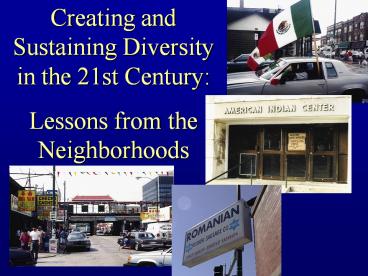Creating and Sustaining Diversity in the 21st Century: PowerPoint PPT Presentation
1 / 30
Title: Creating and Sustaining Diversity in the 21st Century:
1
Creating and Sustaining Diversity in the 21st
Century Lessons from the Neighborhoods
2
Important time in U.S. history
- We are becoming a more diverse nation
- By 2050 it is projected that the U.S. population
will be 50 minority
3
(No Transcript)
4
And there is increased acceptance of diversity
- According to a 1997 Gallup Poll
- ?61 of all Whites 83 of all Blacks in the
U.S. stated that they would rather live in a
neighborhood with both black and white families. - ?When Whites were asked if they would move if
Blacks moved into the neighborhood in great
numbers, only 18 reported that they would move.
In 1967 this figure was 72.
5
Increased acceptance of diversity
- A 1997 Boston Globe poll found that
- ?Almost 90 of blacks, whites, Latinos, and
Asians say they have developed friendships that
cross racial and ethnic lines - ?Although many Americans still chose to live
with their own ethnic or racial groups, strong
majorities of all colors profess tolerance of
other races and ethnic groups
6
Existence of stable, diverse neighborhoods
- Racially, ethnically, and economically diverse
communities exist in many cities - Bucking the stereotype that a diverse
neighborhooda changing neighborhood - What factors contribute to stable diversity?
7
Research focusing on the positive story
- Focus on policies strategies that have brought
and can bring about stable diversity to urban
neighborhoods - We know there is greater demand for diverse
neighborhoods than there are diverse
neighborhoods available - By presenting positive examples of stable
diversity, we can short circuit notion that
diversity is only a temporary point in
resegregation
8
The Study
- Coordinated by the Loyola University Center for
Urban Research and Learning, the Policy Research
Action Group, and the Leadership Council for
Metropolitan Open Communities - A collaborative universitycommunity,
researcherpractitioner effort - Funded by HUD
9
The study
- Diversity is defined as how close each tract
came to the whole citys racial and ethnic
composition - Stable is defined as approximating this
diversity for two consecutive census years (1980
and 1990)
10
Which communities did we study?
- Fourteen neighborhoods in nine cities
11
Place US map with studied cities here
12
Which communities did we study?
- New York City
- Jackson Heights, Queens
- Fort Green, Brooklyn
- Philadelphia
- West Mt. Airy
- Memphis
- Vollintine-Evergreen
13
Which communities did we study?
- Milwaukee
- Sherman Park
- Chicago
- Rogers Park
- Edgewater
- Uptown
- Chicago Lawn (Marquette Park)
- Denver
- Park Hill
14
Which communities did we study?
- Houston
- Houston Heights
- Oakland
- Fruitvale
- San Antonio
- Seattle
- Southeast Seattle
15
Common Characteristics
- Attractive Physical Characteristics
- Mixture of types of diversity
- Within blocks
- Small pockets of racial/ethnic homogeneity
- Presence of social seams
- Residents awareness of their communitys stable
diversity - Community-based organizations contributing to
maintaining diversity
16
Common Characteristics
- Moral or value-oriented component to community
organization/institution involvement - Efforts to spur economic development
- Common Challenges
- transition from older to younger residents
- addressing community disinvestment
- community safety
- schools
17
Common Challenges
- Transition from older to younger residents
- Addressing community disinvestment
- Community safety
- Improving quality of education
18
Two models of diversity
- Diversity by Direction
- Diversity by Circumstance
19
Diversity by Direction
- Emerged out of civil rights movement of the 1960s
- actively market themselves as diverse
- developed an array of community
organizations, social networks,
institutional accommodations
to sustain diversity
20
Diverse by Direction
- Community-based organization intervention
- promoting positive perceptions
- affirmative marketing programs
- monitoring fair housing laws
- addressing quality of life concerns
- Religious congregations play prominent role
- Social seams well developed
21
Diverse by Direction
- More political and financial resources
- Working relationships with banks and real estate
agents - Emergence of strong leadership within community
- Bi-racial or bi-ethnic, rather than
multi-racial/ethnic character
22
Diversity by Circumstance
- Community has not worked directly to
develop/sustain its diversity the
community happens
to become diverse
23
Diversity by Circumstance
- Result of economic social processes not
directly related to resident or community
organization actions, such as - gentrification stalled by poor real estate market
- establishment of port of entry for new immigrants
- revitalization of adjacent areas/spill-over
investment - transition because of aging population
- development of affordable housing
- Social seams not as visible or as strong
24
Diversity by Circumstance
- Multi-racial and/or multi-ethnic
diversity
- Network of community organizations that
represents different ethnic/racial group interests
25
Diversity by Circumstance
- Lower median income
- Affordable housing represents larger portion of
housing stock
26
Diversity by Circumstance meeting the challenges
- Religious institutions act as bridges between
multiple ethnic groups - Developing efforts to weave together various
ethnic and racial groups
27
Recommendations Conclusions
- Develop strategies to strengthen community-based
organizations - Establish regional networks of diverse
communities - Create leadership training institutes
- Public private agencies should earmark
resources specifically for diverse communities
28
Recommendations Conclusions
- Increased receptivity to new immigrant groups
- Maintain or strengthen fair housing laws,
anti-discrimination laws, the Community
Reinvestment Act, other related state local
laws - Government agencies should be proactive in
promoting diverse neighborhoods
29
Recommendations Conclusions
- The media should take an active role in telling
positive stories of diverse community successes - Support public private programs supporting
mixed-income developments - Business should look carefully at diverse
communities as potentially strong markets - Bolster the quality of local schools
- Promote efforts to improve community safety
30
Looking ahead to the future...
- We can end the notion that the only stable
neighborhood is a segregated neighborhood
Greenhouse/Boston Globe

